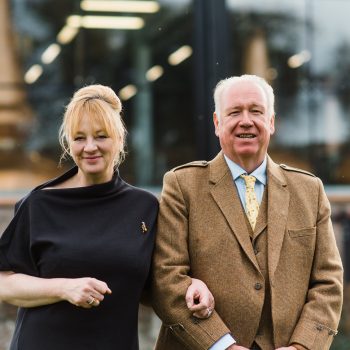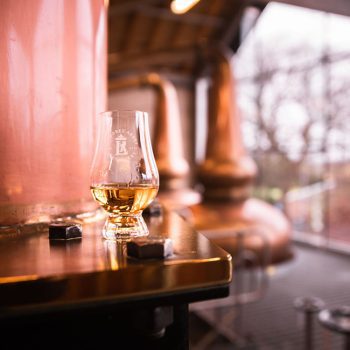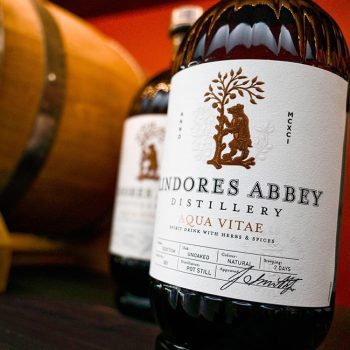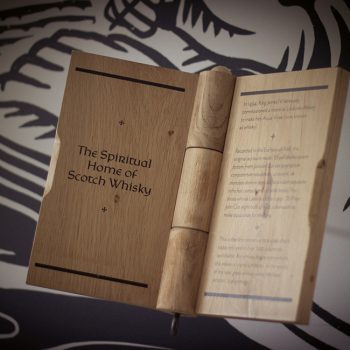Inside the ‘spiritual home’ of Scotch
By Lauren BowesWhen it comes to Scottish whisky, heritage is often a selling point. But at Lindores Abbey Distillery in Fife, it’s more than just a marketing hook – it’s the very foundation of the business.

The distillery sits across from the ruins of Lindores Abbey, a Tironensian monastery widely acknowledged as the spiritual home of Scotch whisky. The first written record of whisky distillation in Scotland appears in the Exchequer Rolls of 1494, which state that malt was sent “to Friar John Cor, by order of the King, to make Aqua Vitae”. That friar lived and worked at Lindores.
“The history has been the gift that keeps on giving,” says founder Drew McKenzie Smith, whose family has owned the Lindores estate since 1913.
Despite the land being part of the family for generations, the McKenzie Smiths were oblivious of its history until whisky writer Michael Jackson came knocking on their door in 2001. Drew’s father Ken happily showed Jackson around without knowing what he was looking for. A few months later, a book arrived in the post.
“The book said: ‘For the whisky lover, it is a pilgrimage’,” says McKenzie Smith. “We were scratching our heads and thinking: ‘That’s the first we’ve heard of it’.”

Setting foundations
McKenzie Smith spent years researching this history before founding the distillery in 2017. The decision was both personal and practical. “The Abbey has been my home for 60-odd years,” he says. “The distilling history side is hugely important and a driving factor. But also, through selling our whisky around the world, it helps us to maintain the monastery.”
Building on such a historic site wasn’t without its challenges. While the distillery is housed in converted farm buildings, the ruins of the original abbey – now a scheduled ancient monument – sit just across the road. Construction required oversight from Historic Environment Scotland and a full-time archaeologist on site.
“I was very confident we wouldn’t find anything,” McKenzie Smith recalls. “Then, on day one of digging, we uncovered a wall that hadn’t been seen in 600 years.” More discoveries followed, which were both exciting and nerve-wracking. “There was a moment where we thought, if we keep finding walls, we might not be allowed to build the distillery at all.”
Fortunately, that moment never came. Today, the distillery has a harmonious relationship with its local archaeologists, with the site even hosting an archaeological field school run by St Andrews University.
The council is also on board. “There was someone in Fife planning who had a bit of a bee in his bonnet,” laughs Andrew. “He always thought the steading should have been listed.” Eventually, someone came to assess the property. “She was disappointed to tell me that the farmstead wasn’t important enough to be listed. She thought it would hurt my feelings, but it was one of the best letters we’ve ever had.”
Making the whisky
Prior to setting up Lindores, McKenzie Smith and his wife Helen worked in high-end hospitality. “We weren’t a whisky family,” he explains. “I was very, very lucky to get a great deal of very good free advice from a lot of well-placed people in the industry.” One of those well-placed people was Dr Jim Swan, who helped to design the distillery and influence its direction.
“It could have been a bit of a Disneyland for whisky,” he says. “But we very quickly decided that while the history is fantastic and our USP, the real point of the project was to have a world-class distillery at Lindores Abney. It was really important that our product matched the history, otherwise it would’ve been a pointless exercise.”

Swan passed away just before the distillery’s completion, leaving the Lindores team to define their spirit style independently. The resulting single malt, called MCDXCIV (1494 in Roman numerals), was aged in a combination of Bourbon and Sherry casks, alongside shaved, toasted, re-charred (STR) red wine barriques – a signature Swan innovation that speeds maturation.
“Our spirit isn’t a typical Lowland profile,” McKenzie Smith explains. “It’s more orchard fruit, vanilla, butterscotch – more layered. We’ve always said we want to make premium whisky, and that means using premium casks, long fermentations, and taking our time.”
Aqua vitae
While it’s become a commonplace practice, releasing gin to keep the business ticking over while its new make spirit aged didn’t appeal to McKenzie Smith. “Our USP is bringing distilling back to Lindores after 520-odd years. We know the monks made beer; we know they made aqua vitae. We know they distilled rose water. But they didn’t make gin.”
Instead, it was that back to those Exchequer Rolls for inspiration. “It was a lightbulb moment” when McKenzie Smith realised the document had said ‘aqua vitae’ – not whisky – all along.
Etymologically, aqua vitae became ‘uisge beatha’ – ‘water of life’ in Scottish Gaelic – which then became ‘whisky’. But the liquid itself also had a transformation over time.

“Back in medieval times, aqua vitae was a raw barley spirit infused with plants and herbs,” explains McKenzie Smith. He partnered with Heriot-Watt University to create what they believed would be a historically accurate recreation, adding plants and herbs that grow around Lindores Abbey to the distillery’s new make spirit.
“The early versions were awful,” McKenzie Smith laughs. Wild garlic grows abundantly in the area, and was likely to do so back in the 1600s – but it didn’t make for a delicious liquid. “We started with total historical accuracy, but it was undrinkable.”
Fixing that involved expanding the project out to consult local mixologists, including those at the Timberyard in Edinburgh, who figured out a new recipe including dates, raisins, sweet cicely, and spices.
“To my knowledge, we’re the only people with our own aqua vitae recipe,” he says. “It’s not aquavit, and it’s not eaux-de-vie – though those both essentially have the same name. It’s something new, but also very old.
“We knew it’d be a big challenge, because you’re creating a whole new sort of category, which does make life hard. But I think with some money and effort, aqua vitae could flourish.”
Matching history and whisky
While McKenzie Smith was determined to create a product range worthy of the site’s history, the guest experience is another key priority. The team’s hard work in this regard has resulted in the distillery ranking fifth in the UK and Ireland’s most popular whisky distilleries list.

“We get visitors from all around the world – people from 70 different countries have visited our little part of Fife,” he says. “They’re predominantly whisky fans, but they probably wouldn’t have heard of us if it weren’t for the history.” And while most guests come for a distillery tour, the experience is broader. “They can walk around the abbey ruins and learn about the history. Without sounding too corny, it’s sort of for the whole family.”
Looking ahead, Lindores is experimenting with a range of wood types, including peated casks sourced from Islay that lend a smoky character without requiring peated runs on site.
And while McKenzie Smith remains open to innovation, he’s conscious of his position. “You can’t call yourself the spiritual home of Scotch and then be a total disruptor,” he says.
One of his daughters is now involved in the business, but there’s no pressure to hand over the reins. “It’s a competitive business,” he says. “We’re all watching what’s happening in the whisky business at the moment.
“Back in the early 2000s, whisky was in a downturn, and we’ve been fortunate with Lindores to experience the upturn. But now, like with almost every other whisky producer – big or small – we’re seeing what’s happening on a global scale. There’s certainly a tightening of belts at the moment.
“But it’d be lovely to think of a future generation. Who knows?”
Related news
Compass Box auctions Scotch-Swedish one-off blend
Oldest Scotch whisky auctions for $160,000
The Singleton: setting the pace for a new generation of Scotch drinkers
